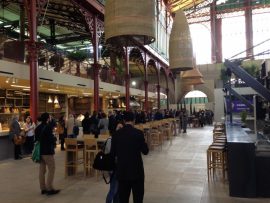Farm-to-Table & Italian Society: A Deeper Look
By Patrice Grande, Nicole Decosta, Leeya Mengistu, and Olivia Huff
There are many phrases to describe one’s diet–vegan, vegetarian, pescatarian– the latest trend of these being climatarian. According to the Barilla Center for Food and Nutrition, the “climatarian culture” has made its way to the millennials of Italy. But what is the climatarian lifestyle, and why is it so popular among their youth?
In 2015, the New York Times highlighted the phrase “climatarian” as a top word of the year. A climatarian is one who holds “a diet whose primary goal is to reverse climate change. This includes eating locally produced food (to reduce energy spent in transportation), choosing pork and poultry instead of beef and lamb (to limit gas emissions), and using every part of ingredients (apple cores, cheese rinds, etc.) to limit food waste.” Over 60% of Italian youth responded that they would be willing to adopt such a lifestyle in a BCFN survey. The benefits of such a diet are beneficial for both the individual and their community. And as one surveys the local markets and food culture of Florence, the foundation to begin the switch to a climatarian lifestyle is already in place.
Walking through Mercato Centrale you see numerous vendors who sell all kinds of produce, meats and cheeses to the local Florentine people. Farm-to-table goods, which are a primary source of food for those who live in Florence, offer a fresher and richer source of nutrients.
 Marco, who was working at the Montanari & Gruzza stand, which primarily sells cheese products, was proud to speak in high regards of the company. Marco continued to describe the process that goes into creating their products, such as the Parmigiano Reggiano which is aged for five years in order to get the highest quality in taste. When receiving more information on the company, we were able to learn that the cream for the cheese is collected daily in the Emilia region, 78 miles north of Florence.
Marco, who was working at the Montanari & Gruzza stand, which primarily sells cheese products, was proud to speak in high regards of the company. Marco continued to describe the process that goes into creating their products, such as the Parmigiano Reggiano which is aged for five years in order to get the highest quality in taste. When receiving more information on the company, we were able to learn that the cream for the cheese is collected daily in the Emilia region, 78 miles north of Florence.
Taking care of the land in which their products come from is extremely important in the production of the cheeses. “We have chosen to care about our land and its biodiversity: our cheese range is highly diversified. We invest on typical milk cattle breed such as the ‘Reggiana’ Red Cow and the Bruna Alpina, cattle varieties whose distinctive features create an aromatic Parmigiano Reggiano D.O.P. cheese that we let age long to make it intense in taste and offer the consumer all the complexity and typical values of a deep cultural history,” as seen on the Montanari & Gruzza company website.Meat and poultry also play a huge role in farm-to-table markets as well. The butchers working at Fria Roberto were in the middle cutting up a chicken as customers walked by. Lorenzo, one of the butchers, explained that the products come from all different parts of Italy. “The rabbit is brought from Forli, a city in Northern Italy. While the chicken is from Modenese, which can be found in the province of Modena,” said Lorenzo.
Produce, which plays a huge role in cooking, can also be found in countless markets throughout Florence. Michaela, who was the owner of a vegetable stand in Mercato Centrale, said “I have been able to sell vegetables to numerous Florentines, as well as owners of small restaurants throughout the town.” Mercato Centrale offers a variety of farm-to-table products that are sold in the central market area, while also offering an area that provides the people of Florence with a variety of freshly cooked meals. 
According to Truly Tuscany, the Tuscan countryside is “truly Italian farm country, harvesting olives, a variety of wines from different grapes and countless grains, which grow extremely well in the hilly soil.” Known for the quality of the food, the Tuscan region prides itself on home grown, rich quality foods. Distributing to countless regions throughout Italy, the Tuscan area has become extremely well known for their farm-to-table lifestyle that they have established.
As agriculture is an important branch of the Italian economy, farm-to-table has aided in keeping the countless markets, and restaurants open and running throughout Italy. Mercato Centrale offers copious amounts of meats, fish, cheeses, breads and wines, and gives the Florentines an opportunity to eat foods that are rich in quality, while also benefitting small business’ and family-owned farms.
The purpose of the farm-to-table movement is to emphasize quality over convenience, focusing on bringing the roots of food quality back to Italy and the remainder of the world, this movement aids in a more healthy, holistic lifestyle. Tracing all the way back to the 70’s, the organic farm to table movement has been growing ever since. Putting more of an importance on what is going into your body is what the purpose of the farm-to-table movement is trying to accomplish.
Another famous farm-to-table restaurant in Florence is La Bottega Del Buon Caffe, which is nestled close to the San Niccolo  tower with a scenic view. What is so special about this restaurant is they have a farm in the country, less than thirty minutes away, at Borgo Santo Pietro where herbs, fruits, vegetables, and even milk are produced. Every morning the shepherd and farmers milk the sheep and deliver it directly to the restaurant where it is turned into fresh cheese and sometimes yogurt, depending on the season. Tuscan honey is another specialty that they create. With bees on site at the farm, honey is gathered at the end of the summer and served with the breakfast buffet at the restaurant. The farm-to-table experience does not just stop with the food though; the Borgo Santo Pietro farm is also a vineyard that produces a variety of wines, also prosciutto from pigs that are free to roam throughout the forest.
tower with a scenic view. What is so special about this restaurant is they have a farm in the country, less than thirty minutes away, at Borgo Santo Pietro where herbs, fruits, vegetables, and even milk are produced. Every morning the shepherd and farmers milk the sheep and deliver it directly to the restaurant where it is turned into fresh cheese and sometimes yogurt, depending on the season. Tuscan honey is another specialty that they create. With bees on site at the farm, honey is gathered at the end of the summer and served with the breakfast buffet at the restaurant. The farm-to-table experience does not just stop with the food though; the Borgo Santo Pietro farm is also a vineyard that produces a variety of wines, also prosciutto from pigs that are free to roam throughout the forest.
When creating a menu for the restaurant it is important to the chef to create cuisines that are unique and seasonal. The flavors in each dish must be fresh, flavorsome and bountiful, which can be achieved by using only fresh foods. The philosophy that comes with farm-to-table are one is cooking a dish with only ingredients that are in season then you do not have to smother them in complex seasonings. The chef at La Bottega is imaginative and innovative with his seasonal recipes and has the reputation of one of Tuscany’s most talented young chefs.
As young people become more aware of how their food habits impact the environment and their health, diets like the climatarian lifestyle will become more popular worldwide. But when it comes to food culture Florence and Italy, the historic farm-to-table industry will continue to prove that this sort of lifestyle is not just a trend, but here to stay.
Mercato Centrale Firenze
Piazza del Mercato Centrale – Via dell’Ariento
Hours (upper level): Daily 8:00am-midnight
La Bottega del Buon Caffè
Lungarno Benvenuto Cellini, 69r
Tel. 055 553 5677
Hours:Tuesday-Saturday lunch 12:30pm-3:00pm; Dinner 7:30pm-10:30pm. Sundays and Monday Dinner 7:30pm-10:30pm